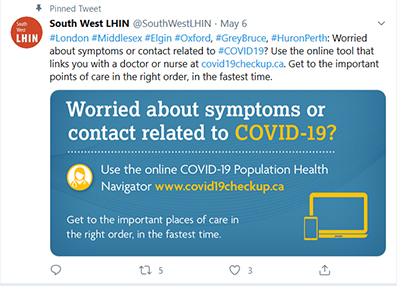Feature: Dr. Daniel Pepe helps to shield the health care system, one virtual visit at a time
By Crystal Mackay
Dr. Daniel Pepe describes it as a digital shield for the health care system. A virtual COVID-19 triage tool designed to protect health care workers while providing rapid care for patients is now being used across Southwestern Ontario.
Two months ago, when the outbreak in Ontario first began to pick up steam, Dr. Pepe, MD’14, an Adjunct Professor in Family Medicine, saw a need in the community to provide patients with a virtual option for assessment. The aim was to prevent them from unnecessarily exposing themselves and others through in-person visits. Within a week, Dr. Pepe had met with leadership from the local hospitals, paramedics, Ontario Health West and the Middlesex-London Health Unit to get the tool up and running.
“Just before everything shut down in Ontario, I was looking at Italy and Iran and I was struck by the seriousness of this illness and its consequences to the health care system. I thought it makes sense to do a virtual assessment first, in a quick fashion, and then triage the most appropriate care after that,” said Dr. Pepe. “It came together in about ten days. I've never seen that much engagement and collaboration between people right across the health care sector. Everyone was contributing in an equal way.”
 Called the Patient Navigator, the tool mirrors the provincial online self-assessment questions, with an added layer of triage by a patient’s primary care provider or an on-call provider if they don’t normally have access to primary care. Based on their online answers to the assessment questions, patients are advised to either go to an assessment centre, visit the Emergency Department at their local hospital or they are connected directly with a primary care provider online, who will assess and provide further guidance.
Called the Patient Navigator, the tool mirrors the provincial online self-assessment questions, with an added layer of triage by a patient’s primary care provider or an on-call provider if they don’t normally have access to primary care. Based on their online answers to the assessment questions, patients are advised to either go to an assessment centre, visit the Emergency Department at their local hospital or they are connected directly with a primary care provider online, who will assess and provide further guidance.
It’s the only tool that uses on-call providers as part of the process in order to connect patients directly with a real person.
Started in London-Middlesex, it is now being used in Oxford-Elgin, Sarnia-Lambton, Huron Perth, Waterloo-Wellington, and Windsor-Essex. To date, more than 20,000 people have used the online tool, and doctors and nurse practitioners from across the region are contributing the care for patients.
Dr. Pepe says they are looking to continue to expand to more geographic locations.
“We're always looking to share what we've learned rather than reinventing the wheel. I've also seen that when we expand across the regions, there are different ways that people approach the same problem, so some of that feedback can be incorporated into the tool which is being constantly updated.” Dr. Pepe says it’s a dynamic tool that's evolving as the situation evolves.
In addition to his role as the Clinical Lead for the Patient Navigator, Dr. Pepe is also the Southwest Digital Pandemic Lead, a larger role within Ontario Health West that is focused on increasing the virtual and digital response to health care in the region as a whole. He is looking strategically at how health care providers can convert their practices, at least partially, into the digital realm in order to reduce clinical risk associated with the pandemic. “That role is also evolving as the pandemic is changing day by day and hour by hour,” he said.
He also sees how some of these digital solutions can carry forward to provide a different patient experiences after the pandemic is over.
“I think some of these virtual solutions are going to stick around. We’ve realized there are a lot of things you can do through a phone call or video chat and in a short time can give you the answer you are looking for,” he said.








